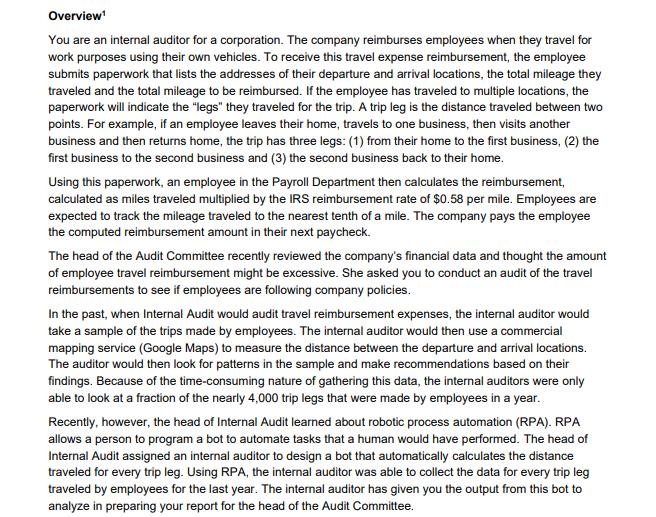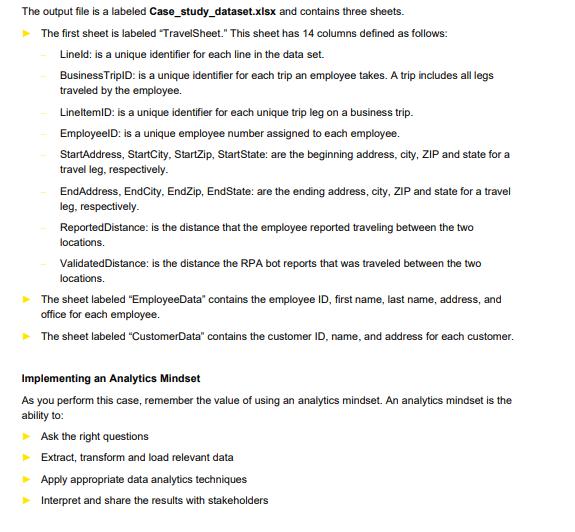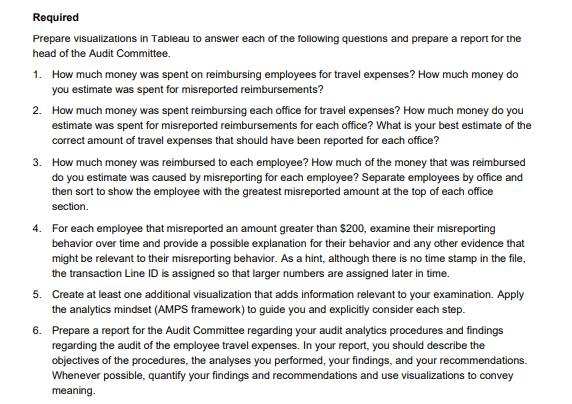Answered step by step
Verified Expert Solution
Question
1 Approved Answer
Overview You are an internal auditor for a corporation. The company reimburses employees when they travel for work purposes using their own vehicles. To



Overview You are an internal auditor for a corporation. The company reimburses employees when they travel for work purposes using their own vehicles. To receive this travel expense reimbursement, the employee submits paperwork that lists the addresses of their departure and arrival locations, the total mileage they traveled and the total mileage to be reimbursed. If the employee has traveled to multiple locations, the paperwork will indicate the "legs" they traveled for the trip. A trip leg is the distance traveled between two points. For example, if an employee leaves their home, travels to one business, then visits another business and then returns home, the trip has three legs: (1) from their home to the first business, (2) the first business to the second business and (3) the second business back to their home. Using this paperwork, an employee in the Payroll Department then calculates the reimbursement, calculated as miles traveled multiplied by the IRS reimbursement rate of $0.58 per mile. Employees are expected to track the mileage traveled to the nearest tenth of a mile. The company pays the employee the computed reimbursement amount in their next paycheck. The head of the Audit Committee recently reviewed the company's financial data and thought the amount of employee travel reimbursement might be excessive. She asked you to conduct an audit of the travel reimbursements to see if employees are following company policies. In the past, when Internal Audit would audit travel reimbursement expenses, the internal auditor would take a sample of the trips made by employees. The internal auditor would then use a commercial mapping service (Google Maps) to measure the distance between the departure and arrival locations. The auditor would then look for patterns in the sample and make recommendations based on their findings. Because of the time-consuming nature of gathering this data, the internal auditors were only able to look at a fraction of the nearly 4,000 trip legs that were made by employees in a year. Recently, however, the head of Internal Audit learned about robotic process automation (RPA). RPA allows a person to program a bot to automate tasks that a human would have performed. The head of Internal Audit assigned an internal auditor to design a bot that automatically calculates the distance traveled for every trip leg. Using RPA, the internal auditor was able to collect the data for every trip leg traveled by employees for the last year. The internal auditor has given you the output from this bot to analyze in preparing your report for the head of the Audit Committee. The output file is a labeled Case_study_dataset.xlsx and contains three sheets. The first sheet is labeled "TravelSheet." This sheet has 14 columns defined as follows: Lineld: is a unique identifier for each line in the data set. Business TripID: is a unique identifier for each trip an employee takes. A trip includes all legs traveled by the employee. LineltemID: is a unique identifier for each unique trip leg on a business trip. EmployeeID: is a unique employee number assigned to each employee. StartAddress, StartCity, StartZip, StartState: are the beginning address, city, ZIP and state for a travel leg, respectively. EndAddress, EndCity, EndZip, EndState: are the ending address, city, ZIP and state for a travel leg, respectively. Reported Distance: is the distance that the employee reported traveling between the two locations. Validated Distance: is the distance the RPA bot reports that was traveled between the two locations. The sheet labeled "EmployeeData" contains the employee ID, first name, last name, address, and office for each employee. The sheet labeled "CustomerData" contains the customer ID, name, and address for each customer. Implementing an Analytics Mindset As you perform this case, remember the value of using an analytics mindset. An analytics mindset is the ability to: Ask the right questions > Extract, transform and load relevant data Apply appropriate data analytics techniques Interpret and share the results with stakeholders Required Prepare visualizations in Tableau to answer each of the following questions and prepare a report for the head of the Audit Committee. 1. How much money was spent on reimbursing employees for travel expenses? How much money do you estimate was spent for misreported reimbursements? 2. How much money was spent reimbursing each office for travel expenses? How much money do you estimate was spent for misreported reimbursements for each office? What is your best estimate of the correct amount of travel expenses that should have been reported for each office? 3. How much money was reimbursed to each employee? How much of the money that was reimbursed do you estimate was caused by misreporting for each employee? Separate employees by office and then sort to show the employee with the greatest misreported amount at the top of each office section. 4. For each employee that misreported an amount greater than $200, examine their misreporting behavior over time and provide a possible explanation for their behavior and any other evidence that might be relevant to their misreporting behavior. As a hint, although there is no time stamp in the file, the transaction Line ID is assigned so that larger numbers are assigned later in time. 5. Create at least one additional visualization that adds information relevant to your examination. Apply the analytics mindset (AMPS framework) to guide you and explicitly consider each step. 6. Prepare a report for the Audit Committee regarding your audit analytics procedures and findings regarding the audit of the employee travel expenses. In your report, you should describe the objectives of the procedures, the analyses you performed, your findings, and your recommendations. Whenever possible, quantify your findings and recommendations and use visualizations to convey meaning.
Step by Step Solution
There are 3 Steps involved in it
Step: 1
Table of Contents Field notes 2 Audit Report 2 1 Reimbursement Spend for Employees Travel Expenses 3 2 Office Reimbursement Spend for Employees Travel Expenses 9 3 Reimbursement Spend for each Employe...
Get Instant Access to Expert-Tailored Solutions
See step-by-step solutions with expert insights and AI powered tools for academic success
Step: 2

Step: 3

Ace Your Homework with AI
Get the answers you need in no time with our AI-driven, step-by-step assistance
Get Started


